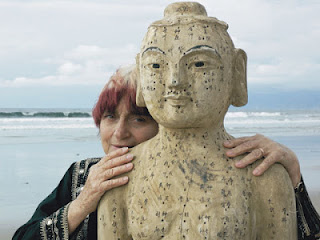Agnès Varda (1928-2019) was a Paris-based photographer and film director and a key figure in modern film history. She is much revered across the globe for her deconstruction of the documentary form and her boundary-pushing work. In a career spanning 57 years, Agnès Varda, is one of the most original and renowned of the French ‘New Wave’ directors; in fact she is the only female director associated with it – her early films anticipating the work of Godard and Truffaut.
In 'The Beaches of Agnes' we are in the mind of an Elder who is ‘essaying’: she weighs up her own life, pays tribute to her lovers, friends, family and colleagues. She time travels back into her own films – and into Demy's films. It is a tribute to cinema – to the nouvelle vaugue, to documentary, to fiction, to imagination, to creativity. There is a great freedom in this film – everything is possible – as in a Melies film. It is magic, the stuff of dreams.
In 'The Gleaners and I' Varda plays with representation – from Millet’s painting – which serves as visual metaphor and foundation text – and she transforms it into her own film text of gleaning. She pushes beyond the surfaces of Millet’s three gleaners and his framing – to blow open the edge of frame and ‘essay’ into her film’s themes; and she gives us herself and her gleaners in fleshy reality.
The people actually filmed in 'The Gleaners' – and the way she films with them – is worth thinking about. How does Varda achieve such a special quality in her interviews? – a feeling of compassion and intimacy – a sense of shared humanity. Varda says this: “The people I have filmed tell us a great deal about our society and ourselves. I myself learned a lot as I was making this film. It confirmed my idea that documentaries are a discipline that teach modesty”.
Last year (2021) I was writing about Varda's unique approach to film-making and I came across a thoughtful interview with her by Sheila Heti in The Believer (Issue 66). Sadly, this online magazine's link is no longer active, but here is a quote that expresses Varda's film-making ethic:
If it can be shared, it means there is a common denominator. I think, in emotion, we have that. So even though I’m different or my experiences are different, they cross some middle knot. It’s interesting work for me to tell my life, as a possibility for other people to relate it to themselves—not so much to learn about me… It’s a way of living, sharing things with people who work with me, and they seem to enjoy it.
Back in 1999, we were blessed to meet up with Agnes Varda at the Creteil International Women's Film Festival in Paris. A group of us Australian women filmmakers screened our films in a program called, Les Antipodes. What a wonderful experience! Varda, one of our great mentors! And yes, we need them.
 |
| Margot Nash, Jeni Thornley with Agnes Varda, Creteil International Women's Film Festival, Paris 1999 |
Notes
Heti, S. (2009, October 1). An interview with Agnes Varda. The Believer. Issue 66. https://believermag.com/an-interview-with-agnes-varda/
Sheila Heti, Interviews. http://www.sheilaheti.com/interviews, accessed 9th August 2022.





























